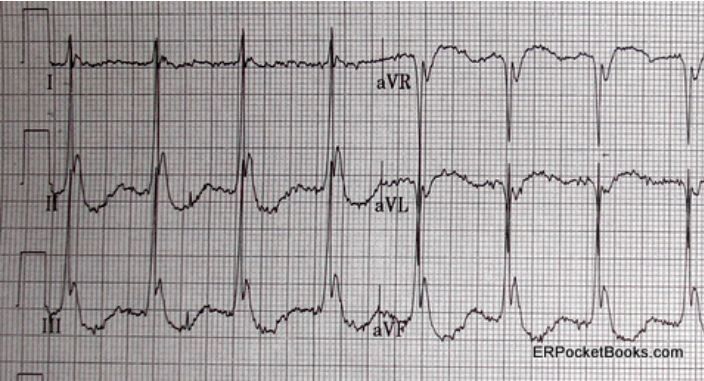- Clinical Technology
- Adult Immunization
- Hepatology
- Pediatric Immunization
- Screening
- Psychiatry
- Allergy
- Women's Health
- Cardiology
- Pediatrics
- Dermatology
- Endocrinology
- Pain Management
- Gastroenterology
- Infectious Disease
- Obesity Medicine
- Rheumatology
- Nephrology
- Neurology
- Pulmonology
Hypothermia in an Elderly Man
Figure. ECG shows Osborne J-waves, shiver artifact. Click to enlarge.

An elderly man is brought to the emergency department by ambulance after he was found in an altered state of consciousness in his apartment. The 911 call came from a “Meals on Wheels” (M-O-W) delivery driver who was worried when no one answered the door. The patient can give his first name, but not much more. The M-O-W driver told medics that the man is on a diabetic diet and that he had last brought him food 48 hours earlier. At that time the patient seemed fine but had mentioned that he had “a cold.”
Medics provide the following report: “We found him lying on the couch, incontinent of urine and stool, but with no evidence of trauma. Pulse 80 and regular, blood pressure 95/60 and glucose 499.” On examination he is lethargic with pupils that are symmetric and react sluggishly to light. His neck is non-tender and supple. His lungs have bilateral rales and ronchi but he is breathing at only about 12 respirations/minute. His heart sounds are normal. His abdomen is non-tender. His extremities have 1+ bilateral edema. His neurological exam is non-focal and he can move all extremities symmetrically but weakly.
The following protocol ECG, ordered by the charge nurse, is given to you by the EMT as you finish your exam.
Given the ECG tracing, what should you immediately order?
What's your diagnosis?
Answer: Immediately order a rectal temperature, a warming blanket, and warm IV fluids. Depending on the temperature you may need more aggressive warming measures.
The EKG shows Osborne J-waves and shiver artifact, both of which are found in hypothermia. Bradycardia is curiously absent, likely the result of severe dehydration.
Discussion
Hypothermia may be categorized as primary, from exposure to the cold; secondary to a medical condition such as sepsis; or a combination of both. Hypothermia can also be categorized by severity with four stages (see Table below, which summarizes the Swiss staging system). Oral and rectal temperatures may be less accurate in hypothermia than bladder or esophageal temperatures. It is also important to know that many hospital thermometers will not measure below 84°F (28.8°C), so if the temperature reads 84°F it is important to obtain a special low-reading thermometer as it may actually register significantly lower.
It is critical to evaluate the hypothermic patient for a contributing or precipitating medical condition. Anything that can debilitate a patient or prevent sheltering behavior can contribute, but particularly common triggers are hip fractures, sepsis, stroke, drug or alcohol abuse, and hypoglycemia or other endocrine conditions. In addition to ruling out other conditions it is critical to carefully monitor the patient’s cardiac status and avoid any rough handling because as the temperature drops the risk of cardiac pathology including fatal dysrhythmias increases. Early ECG findings in hypothermia include bradycardia, atrial fibrillation, shiver artifact, and Osborne J-waves. A handy mnemonic for this is “BASO.” Of these findings Osborne J-waves are the most specific for hypothermia.
Treatment of hypothermia involves treating any precipitating conditions and rewarming the patient. For the majority of patients who are stable or semi-stable, passive rewarming has the least chance of complications. Methods include warm packs, warm IV fluids, and warm air convection blankets. For unstable patients or severe hypothermia, invasive rewarming techniques should be considered. (See Table below for details)
The pulse may be slow and very weak in hypothermia therefor patients that appear to be in PEA should have pulses checked by Doppler before initiating CPR. It is important to know that hypothermia can mimic death. Hence the phrase “a hypothermic patient is not dead until warm(ed) and dead (unless there is lividity, a temperature below 60°F [15.5°C], or a potassium level >10).”
Table
